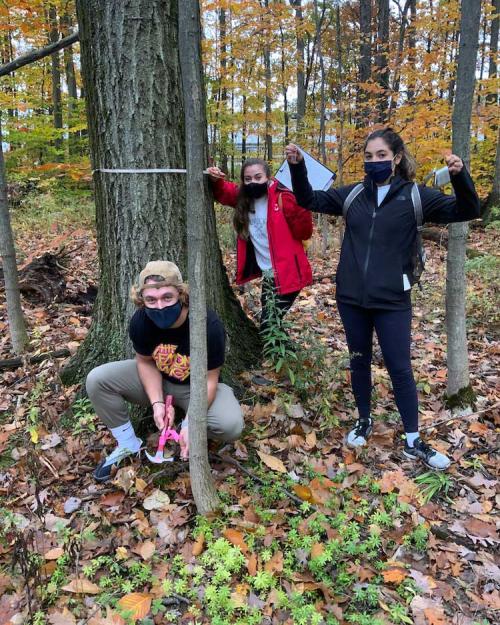Biologist Michelle Smith discovered the wonders of the ocean while taking a field course in Friday Harbor, Washington, as a doctoral student.
“When you rowed a boat at night the water all around you would glow because of bioluminescent organisms. Learning about the ocean transformed me,” said Smith, the Ann S. Bowers Professor in the Department of Ecology and Evolutionary Biology and Senior Associate Dean for Undergraduate Education in the College of Arts and Sciences.
David Esparza, doctoral student in ecology and evolutionary biology, had a similar awakening doing field research with the Bee Biodiversity Research Group as an undergraduate at the University of Texas at El Paso.
“Studying the native bees and flora of the Chihuahuan Desert transformed my view of the region I grew up in by providing me with a sense of place and a greater appreciation for my home,” said Esparza, who is a Sloan Diversity Fellow and a National Science Foundation Graduate Research Fellow.
While many scientists have similar stories about field courses shaping their careers and benefiting their students, Smith said, few studies quantify their effects. At a time when field course offerings are in decline and enrollment in existing courses is not keeping up with the number of students in natural sciences fields, a baseline study is needed, she said.
To establish statistics about the current state of field studies and to identify places for future growth in this natural setting for active learning, Smith and a team of Cornell researchers from the Colleges of Arts & Sciences and Agriculture and Life Sciences, including Esparza, surveyed previous research on field courses.
"The impact of field courses on undergraduate knowledge, affect, behavior, and skills: A scoping review" was published in the journal BioScience on Aug. 24.
“Field courses engage all five senses and give students a new way to see the natural world and a deeper understanding of an ecosystem, all of which can contribute to the development of a profound sense of place, a deeper connection to nature, and a desire to protect it,” said Kira Treibergs, a postdoctoral associate in the Department of Ecology and Evolutionary Biology (A&S) and one of the lead authors. “Better understanding the existing body of literature about the outcomes of field courses can help us to identify where future research is needed to ensure that these unique learning experiences persist in undergraduate education.”
Not many studies quantify the impacts or spell out the challenges of field courses, said lead author Xoco Shinbrot, previously an Active Learning Initiative postdoctoral researcher in the Department of Natural Resources and the Environment (DNRE). “This article fills that gap.”
The Cornell researchers found 61 articles published between 2010 and 2019 reporting on undergraduate participation in and outcomes from field courses offered by American universities and colleges. The team classified course outcomes in four categories: knowledge, affect, behavior, and skill-based outcomes of field course participation.
Cost was the most commonly reported barrier to participation, the study found.
Field courses can sometimes have higher costs to students when compared to classroom courses, Treibergs said, and because field courses involve bringing students to outdoor environments they can sometimes pose higher risks. Field courses can also be expensive for departments to support and labor intensive for instructors to plan.
“This scoping review underscores the need for rigorous and evidence-based investigations of student outcomes in field courses,” Smith said. “We plan to build on this literature base and promote Cornell as a leader in education research about field courses.”
The researchers have several future projects planned, Smith said. Co-author Ash Heim, ecology and evolutionary biology postdoctoral researcher, is designing a new assessment instrument that measures student critical thinking skills in ecology courses.
In addition, Treibergs and Esparza are leading a study analyzing the major themes students write about in their field journals. Esparza studies the social network connections students make in field courses and how these connections impact what students learn and their science identity.
Smith said natural science instructors and students at Cornell benefit from a rich history of support for field courses. Esparza added that many accessible local spaces that provide field course opportunities, including the Arnot Forest, Sapsucker Woods and the Susquehanna River Basin.
“By hosting field courses nearer to campus, rather than in remote locations, institutions and instructors can make field courses more accessible for students of all backgrounds,” Esparza said.
Nationwide, however, access to and inclusion within field courses continue to be major concerns that instructors and administrators must address, particularly for students who are historically excluded due to race and/or ethnicity, disability, first generation or socioeconomic status.
“Moving forward, field course research must prioritize accessibility and inclusion,” Smith said, “and that includes reporting data on student factors such as demographics and prior experience, and assessing student affective and behavioral outcomes, which were underreported.”
This research was supported by the National Science Foundation and the Active Learning Initiative at Cornell.





